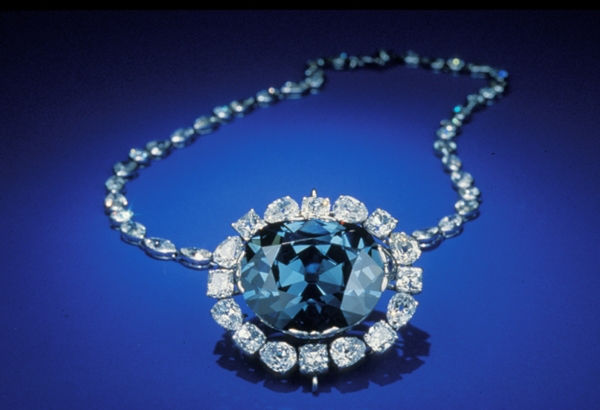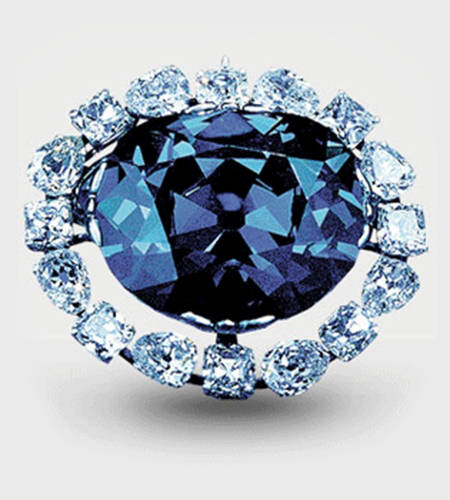Hope Diamond – A Blue Legend
- Home /
- Famous Diamonds /
- Hope Diamond
Some of the most beautiful things in existence can't be entirely explained. The same can be said for the legendary Hope Diamond - a world-famous gemstone that has gathered quite a complicated reputation. Over the years, a slew of different stories have emerged about the diamond's journey, and with so many discrepancies, it can be difficult to determine what's true and what's fabricated. Still, one thing can certainly be agreed on: The Hope is a remarkable stone - one that boasts such an impressive hue, weight, cut and clarity that a comparable colored gem may never be found again.
The Hope Diamond isn't just one of the largest blue diamonds in the world - it's also one of the most visited museum pieces in existence. Part of the stone's charm is not just its undeniable beauty, but also the mystery its history is shrouded in. Is the Hope Diamond actually cursed? Or are the unfortunate events that befell its owners merely a string of coincidences?
 The Hope Diamond
The Hope Diamond
Let's explore some of the lore, from its original discovery to today.
Where did the Hope Diamond come from?
For many years, the origin of the Hope Diamond was based on speculation, though it was widely accepted that the gem was discovered in India. However, researchers spent a full year analyzing and studying the stone, and were able to determine that it dates back to roughly 1668.
These findings confirm that the Hope Diamond was originally part of the crown jewels of France. According to LiveScience, merchant Jean Baptiste Tavernier stole the stone from the eye of a Hindu idol statue, brought it to France and sold it to King Louis XIV. Then, the diamond was cut into a 69-carat stone called the French Blue, which was later stolen by thieves when Louis was executed during the French Revolution.
The diamond disappeared for decades and eventually turned up in London. Financier Henry Philip Hope purchased the stone, which had been cut down from its original size, in 1839. Over the years, the Hope Diamond continued to change hands several times. Hope's son, Lord Francis, had to sell the stone when he became bankrupt, and eventually was bought by American jeweler Pierre Cartier. The next owner was the chic Washington socialite Evalyn Walsh McLean. From the moment she bought the diamond in 1912, her life became a series of tragic events that only fueled the diamond's destructive reputation.
The Hope Diamond curse
Still, the curse of the Hope Diamond goes way back to Tavernier. It was long believed that after Tavernier plucked the gem from the Hindu statue, he was torn apart by wild dogs - a karma-inspired event for his sacrilegious theft. However, LiveScience noted that other stories indicate Tavernier died peacefully in Russia years after he sold the gem to King Louis XIV.
 The Hope Diamond
The Hope DiamondImage via GIA
Yet there are many other tales of tragedy related to the Hope Diamond. For example, PBS pointed out that Louis XIV died from gangrene, a horrible disease, while in possession of the stone. His mistress reportedly became undesirable to the King once she wore the diamond. Nicholas Fouquet, guardian of the French Crown jewels, donned the stone for a special occasion and later on, was not only imprisoned but also put to death at Louis' command. Both Louis XVI and Marie Antoinette lost their heads to the guillotine during the French Revolution while it was under their ownership. Princess de Lamballe, a member of the King's court who also wore the stone, is believed to have been mauled to death by a French mob.
The devastating events don't stop there. PBS reported that the Dutch jeweler who recut the Hope Diamond in the early 1800s was robbed and murdered by his own son, Hendrik, who killed himself in 1830. Other misfortunes include King George IV, who died in immense debt while possessing the stone; Lord Francis Hope, who experienced detrimental scandals, suffered a miserable marriage and financial struggle; and his wife, May Yohe, who died in poverty. Jacques Colot, the next owner, is believed to have gone insane and committed suicide, and after that, Prince Ivan Kanitovski was supposedly murdered by Russian revolutionaries.
After obtaining the diamond from Cartier in 1912 for $180,000, Evalyn Walsh McLean's life took a depressing turn. Her daughter overdosed on drugs at 25 years old, her first born son was killed in a car crash at just 9 years old, and her husband left her for someone else, suffered a brain atrophy and was eventually committed to mental hospital, where he died. Interestingly, the National Postal Museum explained that McLean continued to wear the stone and refused to sell it, as she was afraid of transferring the bad luck to others. The Hope Diamond was found in her $4 million jewelry collection, which was kept in shoeboxes in her bedroom, after her death in 1947.
According to LiveScience, the Smithsonian once noted, "More than anyone, Evalyn Walsh McLean became the poster child for the Hope diamond's legendary curse."
Additionally, certain accounts reveal that James Todd, the mailman who delivered the stone to the Smithsonian, got his leg crushed in a truck accident and later lost his home to a fire.
Some maintain that Cartier fabricated or exaggerated many of these details to build intrigue around the stone. Regardless, these worrisome stories were convincing enough to cause much concern over handling the Hope Diamond.
How much is the Hope Diamond worth?
Being one-of-a-kind, it is practically impossible to assess the Hope Diamond's value. However, Exploring Life's Mysteries asserted that the worth is roughly $250 million. There are a variety of details that contribute to this estimate of the Hope Diamond's price.
For one, in 1988, the Gemological Institute of America determined that the stone weighed 45.54 carats - about the size of a walnut. In addition to the impressive size, the gem boasts a uniquely striking hue. What color is the Hope Diamond? The GIA graded it as a fancy deep grayish blue, which helps to distinguish it from the tone of a typical sapphire.
Even more remarkable is its phosphorescence. The Hope Diamond emits an awe-inspiring red glow when exposed to short wave ultraviolet light - and this effect continues for a short period of time even after the source of light is no longer present. While some thought this was a sign of the stone's inherent curse, Exploring Life's Mysteries explained that it's an indication of the boron and nitrogen trapped in its structure. The gem has been classified as a Type IIb diamond, which means it is also semi-conductive.
Adding to the Hope Diamond's beauty is its cut, which the Smithsonian described as a cushion antique brilliant with a faceted girdle and extra facets on the pavilion. The stone's clarity rating is VS1, which means that its minor inclusions are even difficult to detect when it's viewed under a microscope with a 10-power magnification.
Who owns the Hope Diamond?
Considering the fate that befell some of the Hope Diamond's owners, it is perhaps best that the Smithsonian Museum currently possesses it.
Parade reported that famed jeweler Harry Winston acquired the stone in 1949, along with others in McLean's collection, after her death. Over the next decade, the gem was featured at numerous galas and other charitable events, and was a highlight at the Court of Jewels exhibition. In 1958, Winston decided to donate the stone to the Smithsonian Institution. Shockingly, Winston sent the valuable gem in plain brown paper through the postal service, via registered first-class mail. He believed this was the safest way to transport the jaw-dropping stone. A multitude of citizens wrote to the Smithsonian, as well as to President Eisenhower, pleading for the museum not to accept the diamond for fear that it would then be a curse on the American people.
The Hope is set in a pendant surrounded by 16 white pear-cut and cushion-cut diamonds, which hangs from a chain that contains 45 colorless diamonds. It has now been on display at the Smithsonian for over 50 years. For added security, the piece was placed on a rotating pedestal behind 3-inch thick bulletproof glass in 1997, according to Parade. It even got its own individual display room, due to the fact that it was such a significant draw for visitors.
Smithsonian magazine detailed that the Hope Diamond has only left the museum four times - in 1962 when it was shown at the Louvre; in 1965, when it was displayed at the Rand Easter Show in Johannesburg; in 1984, when Winston loaned the diamond for his company's 50th anniversary celebration; and in 1996, when it was given back to Winston briefly for minor reconditioning and cleaning.
